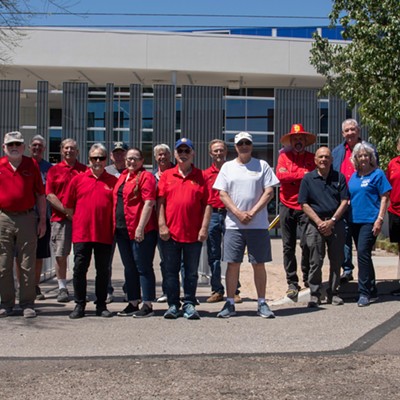To Christopher Corbally, science and religion do not conflict. Period.
He holds degrees in physics and astronomy. He has studied the structure of galaxies, classified stars, worked as a vice director at a famous observatory and been an active member of international astronomy associations. And he is a Roman Catholic priest.
"If through scientific method we find out about the truth in the universe, then that truth, the source of that truth, is the creator," the Rev. Christopher Corbally says in his UA office.
Two colorful images of stars decorate an office wall. A book titled Evolution sits next to his computer.
"You might find apparent conflict, in which case the questions get interesting," he says comfortably. "But fundamentally, there's not going to be."
Evolution. The Big Bang theory. Big questions demand big answers. Modern society often divides science and religion in two, but for Corbally and the priest-astronomers who work for the Vatican Observatory, science and religion are more than compatible. They are unique to humans—and a necessary part of culture.
Corbally trained for 21 years to become a Jesuit. He earned several degrees along the way, including an undergraduate degree in physics from Bristol University, a master's degree in astronomy from the University of Sussex, a bachelor of divinity degree in theology and a pastoral diploma from Heythrop College at the University of London and a doctorate in astronomy from the University of Toronto.
Since earning his final degree, Corbally has devoted much of his time to the Vatican Observatory. He credits his desire to work at the observatory to a summer he spent at its headquarters in Castel Gandolfo, Italy, as an undergraduate.
The Vatican Observatory, re-established in 1891 in Vatican City, stemmed from early observatories and more than three centuries of astronomical research by the Roman Catholic Church. The headquarters were moved to Castel Gandolfo in the 1930s because of light pollution in Rome. In 1981, when the new location became too bright as well, the observatory opened a research arm based at the UA and hosted by the Steward Observatory.
Today, a mix of Jesuits, a priest from the Diocese of Padua, brothers and lay astronomers still work at the observatory. Corbally and five others are based in Tucson. "In our outreach, we are really trying to implement and argue that science and religion are complementary if they're understood," says the Rev. William Stoeger, a Jesuit priest who works with Corbally. "What science is studying are the details of creation."
Ask Corbally about the sunglasses he wears while performing an astronomy skit in lieu of a lecture at science conferences, and his face lights up. "You mean the space goggles?" he asks.
The skit is part of a new research venture called the Human Sentience Project, in which he and colleague Margaret Boone Rappaport, an anthropologist and writer, use performance, research, dialogue and publications to encourage people to think outside the box about science, religion and art. The scenes in the skit compare supernovae, or exploding stars, in the context of past, present and future culture.
It's the year 3054, Corbally explains. He and Rappaport stand onstage. Corbally, wearing black from neck to toe and matching wraparound sunglasses—er, space goggles—represents his future priest-astronomer cousin.
Rappaport, representing her future relative, wears the same outfit but in white. From her position on Jupiter's moon Europa, Rappaport's character spots a supernova. She relays the news to the priest-astronomer, who is 40 light-minutes away on Earth's moon. He sets up his telescope in time to watch the explosion. The two characters can easily observe the event and explain it through science.
Corbally and Rappaport now flash back to 1054, when a bright star appears in the sky and fades more than a year later. The chief astronomer in China waits weeks to present an explanation to the emperor that fits in with Chinese culture. He finally calls the celestial event a "guest star." Unbeknown to him, scientists will later identify it as a supernova, and its remnant will become the Crab Nebula.
Now in the present, Corbally and Rappaport lead a discussion with an audience of astronomy enthusiasts: How will human thought have changed over these 2,000 years? What might these supernovae have meant to each culture?
The skits are basically a dialogue between a priest and an anthropologist about the evolution of human thought, Rappaport says. "The ability to think scientifically only arose in one animal: us."
She and Corbally refer to the highest level of human thought as "matrix thinking." It is "what makes humans human," Corbally says.
The two scientists met in 2006 and discovered a common interest in the way humans think. They are currently writing a book about matrix thinking and plan to present the skit in high schools and universities, starting with a Tucson high school this spring.
"We must tell young people about (these ideas) so that they can be comfortable," Corbally says. "It's natural to be religious, to be scientific and to be artistic."
Ask Corbally about evolution and the Big Bang theory, and he directs you to the Bible.
"Genesis is not trying to teach us about science, but about our relationship with the created world and obviously with the creator," he says. "So once you realize that, then there's no conflict."
He picks up the book Evolution from beside his computer and dons a pair of thin, wire-framed glasses. A small-framed man of average height, with a British accent and silver hair parted on the side, he seems ready to introduce a story for Masterpiece Theatre.
"Evolution is our best science story at the moment," Corbally says. He does not go into detail about the creation of the universe or the evolution of living things. He speaks of "big history"— the evolution of planets, rocks, life, humans, society, culture and religion. "Big history includes everything." And there, his explanation ends.









